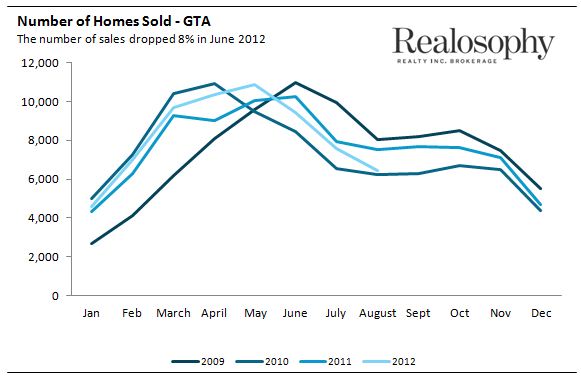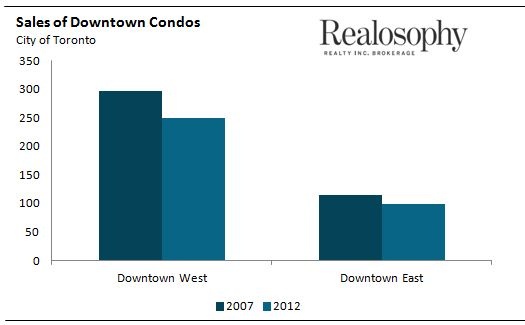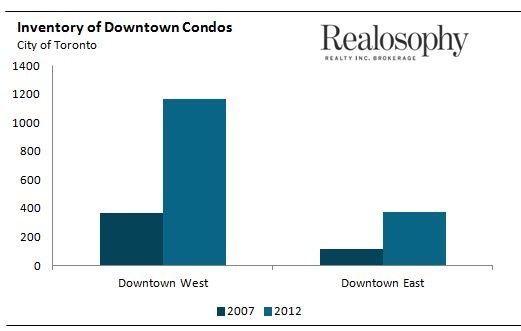John Pasalis in Toronto Real Estate News, Condo Buying
The Toronto Real Estate Board released their August sales statistics yesterday and while there are a couple of interesting stories behind the numbers, I’ll focus today’s blog post on the statistics behind Toronto’s condo market.
Sales in the GTA continued to decline in August showing a 15% drop over the same month last year.
When we zero in on the Toronto market (vs GTA) and look at the change in sales by house type we see that the decline in sales was pretty consistent across the four main house types.
While a 20% decline in sales may seem worth discussing in more detail, I don’t think it’s worth spending too much time analyzing this drop. The decline in sales last month has more to do with the fact that Toronto had a very strong spring market so by the time the summer came around the market had lost a lot of its steam. New buyers typically enter the market early in the new year to buy in the spring or late in the summer or early September to buy in the fall. Expect to see sales pick up again in September as more buyers enter the market.
Now if we look at the change in inventory (houses available for sale) by house type in Toronto last month, we see an interesting story emerge.
There were 21% more condos available for sale this year over last year compared to a 5% increase in detached homes and a decline in semi-detached houses and condo townhouses.
This sharp increase in inventory helped push the average price for a Toronto condo down 4%.
In comparison, the other three house types recorded an increase in their average price over last year.
While the above statistics are only a one-month snapshot of the market, they do highlight a gradual trend we have been tracking internally here at Realosophy - the demand for resale condos in Toronto has not been keeping pace with the supply of condos coming onto the market. (A quick note on what we are measuring here - the MLS tracks resale condos, not new construction. It's safe to assume that many of the condos being sold on the MLS are in newly completed condo buildings.)
To demonstrate this trend I’m going to compare the sales statistics for the downtown condo market (south of Bloor) in August 2012 to August 2007 to see how the market has changed in 5 years. The Downtown West area is roughly between Yonge and Dufferin while Downtown East is between Yonge and the DVP.
The following chart shows the sales for both areas for August 2007 and August 2012.
You can see that the sales volumes in 2012 are down from 2007 but not by much.
Now, let's look at the supply side. The following chart shows the number of condos available for sale during the same two periods.
Houston, we may have a problem. The number of condos available this August is three times the number available five years ago. It’s this increase in inventory that is pushing the condo market into a buyer’s market.
The following chart shows how dramatically the market has changed in five years. The sales-to-inventory ratio measures the number of sales in a given month compared to the number of properties available for sale. If 50 properties sell in August and at the end of the month there are 100 properties available for sale we have a sales-to-inventory ratio of 50%. A high sales-to-inventory ratio (above 30%) tells us that there are more buyers in the market than there are available properties - this favours sellers. A low ratio (below 20%) suggests that the supply of properties exceeds the demand from buyers.
Five years ago, the sales-to-inventory ratio for downtown condos was in the 80% - 100% range which is incredibly high. A sales-to-inventory ratio of 100% means that there is only one month’s worth of available inventory on the market (a pure seller's market). Fast forward to today, and the sales-to-inventory ratio is hovering around the 20% -25% range, which means there is 4-5 months of available inventory on the market.
The market has moved into the balance range of 20-30%, closer to the lower-end, favouring buyers. This with an estimated 50,000 plus units under construction in the GTA. This suggests we can expect to see the downward pressure on the sales-to-inventory ratio continue, unless the demand that new construction proponents are expecting by way of immigrants, young buyers and renters materializes in a big way.
Will the demand show up? We’ll have to leave that discussion for a future post but I will end by saying that understanding the hyper-local trends in the condo market is critical. Even if we continue to see a slowdown in the condo market it’s going to be important to know what neighbourhoods and what buildings are more vulnerable than others. Realosophy will be tracking this closely.
The Bigger Picture
This Monday September 10th marks the start date for the Competition Bureau’s trial with the Toronto Real Estate Board. One of the key issues in this trial relates to whether or not real estate brokerages like Realosophy should get access to raw sold MLS data to perform more detailed analysis about Toronto’s real estate market.
Currently, TREB does not give brokerages like us access to their raw MLS sold data which means that even straightforward statistics like the one in this post are extremely time consuming because it involves accessing data from various websites and pdf files. (Yes, this means that we do a lot of cutting and pasting before we can even get to the analysis part of our process.)
Readers of Move Smartly will not be suprized to know that Realosophy will be an active participant in the trial because we believe that we can only provide you with high value-add agent services when we are able to give you fact-based, analytical advice to help you make better real estate decisions.
Stay tuned.
Related Posts:
Search all MLS Listings by School District? Realosophy Makes it Happen
Flaherty Should Cool Toronto's Condo Market (Not Just Warn Us About It)
John Pasalis is the President and Broker-Owner of Realosophy Realty Inc. Brokerage in Toronto. A leader in real estate analytics and pro-consumer advice, Realosophy helps clients buy or sell a home the right way. Email John











